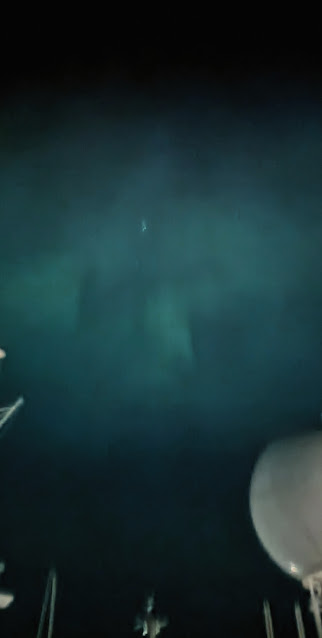The Safari arrived in Lerwick harbour and watched the deckhands getting the tenders ready for the shore excursions, this time we weren't berthed at a quayside but anchored some way off shore. With plenty of official excursions for the guests it was going to be some time before we'd get the chance to get ashore as 'just' a foot passenger. It did give us time to scan the surroundings for whatever might be about which would hopefully include an Otter or two seeing as how Shetland is very much a hotspot for them.
Eventually we got ashore and the whole OWE team decided on a wander up to Clickimin Loch with its Iron Age broch on the shoreline. As we approached the loch the large Tesco supermarket lured us in while the others went on ahead. Bad move on our part as they had a male Hen Harrier cruise along the fellside beyond the lake. At the broch the Starlings were magnificently irridescent in the sunshine.
Others picked through the tufty Lichens gowing on the ancient wallsGetting hungry we headed back into town aand the harbour area where Common Terns rather than gulls were on the look out for chips!
While waiting for our tender ride back to Borealis and its more than copious amounts of good grubwe watched a Black Guillemot fishing close to the jettyAfter yet another substantial lunch we chilled out on the outdoor lounge area at the stern of the ship enjoying the view and having a good old chin wag with some of the guests.
Our search for Otters was unsuccessful but there were two Great Northern Divers and a single Black Throated Diver in the harbour area. A Snow Goose may or may not have been a genuine wild bird but either way its gone on our year list.
The next morning MK did the guest commentary for the scenic cruise by Troup Head on the NE corner of Aberdeenshire, an RSPB reserve home to Scotland's largest mainland Gannet colony.From the ship the Gannets made the cliff face look like it was covered in snow. Some of them were diving for fish but too far for pics others were collecting seaweed for their nests.and as usual it was difficult to get some guests onto the Puffins that were sat on the water or flying past.
By this stage of the trip most guests who wanted to see Puffins, and my are they popular!, had done so and some who'd been on shore excursions had seen them by their burrows but there were still a few folks who'd not yet connected. But why did it prove so difficult to get folk onto them? We've come to the conclusion that several factors are at play...a) many folk don't realise how small they are, only like two tennis balls stuck together, we get the impression they expect something the size of an Emperor Penguin b) when looking down from the ship on them they are really really small and the colourful bill hard to see unless the light is good, even from Deck 3 they're going to be at least 100 feet way and from Deck 6 twice that and more, c) in flight they're fast little suckers and that combined with d) generally poor quality bins and e) inexperience of using said bins means folk don't get onto them when we point them out. Their excitement is infectious when folk do see one for their first time though
When day broke on our final sea day we were well E of Scarborough on the Yorkshire coast so no surprises that Gannets and Kittiwakes Bempton Cliffs RSPB reservewere the majority of the birds seen in the first few hours. We did an ‘Introduction to the Identification of North Atlantic Gulls’ talk in the theatrebut outside there was a different wildlife focus on Deck 3 with moths and hoverflies being attracted to the ship as they migrated across the North Sea, many people don't realise that huge insect migrations go on largely unseen except in unusual circumstances like these today. There were hundreds of these small Dipteran flies
a couple of Silver Y moths
and an Angle Shades moth who's dead leaf camouflage was worse than useless on the brilliant white paint of the ship's superstructure.
Hoverflies were represented by several Drone Flies, Eristalis pertinax, a couple of Marmalade Hoverflies, and this one on IH's cap we at first thought was a Marmalade Hoverfly but on downloading the pic back at Base Camp is obviously something else.As expected travelling closer too land past the Essex coast down to the Straits of Dover proved to be productive with over half a dozen Harbour Seals being spotted and six Harbour Porpoises, kept company by flocks of Kittiwakes, Guillemots and by Gannets. A great end to a fabulous week - early the following morning we would be back on dry land saying fond farewells to SB and MK, we're sure our paths will cross again before too long, and be heading up the motorway back to Base Camp for a well earned rest.


















































